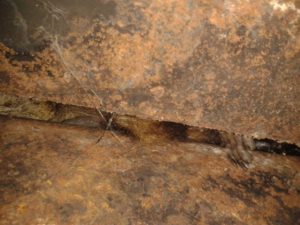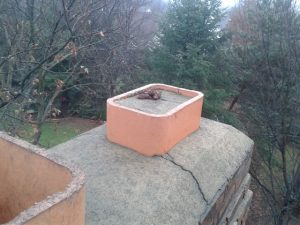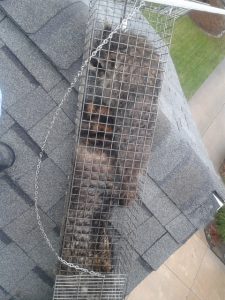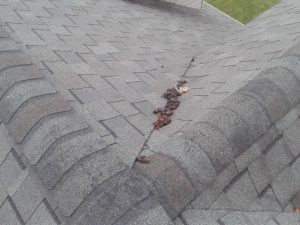Noisy Raccoons in Fireplace Removed
 There’s been some strange noises from the fireplace and residents suspect an animal is living in it. Is it squirrels, birds, or raccoons?
There’s been some strange noises from the fireplace and residents suspect an animal is living in it. Is it squirrels, birds, or raccoons?
Well, this one was pretty easy to figure out with a quick glance from below.
Take a look at this picture which was taken from inside the fireplace looking up.
The pieces of metal are the doors of the damper. And right there, where the damper doors meet, are a raccoon’s fingers!
Since the damper is closed and latched, there is not much chance that the raccoon will end up in the bottom of the fireplace.
But, this raccoon’s current living room is very close to this family’s living room; a situation which needs to change.
Raccoons in Chimneys & Fireplaces
Raccoons naturally den in hollow trees. They’ll find a hollow in a mature beech tree, climb in, and make a cozy den.
Chimneys and fireplaces, though man-made, resemble these natural spots and provide good shelter. Consequently, many raccoons in our suburban/urban environments associate chimneys with comfort.
Our raccoon-in-the-chimney service calls peak in spring when mother raccoons give birth to babies in these secure spots. But, during the winter, these types of calls come in too as raccoons seek shelter from the cold weather.
The common denominator for all types of raccoon-in-the-chimney calls is the lack a chimney cap.
 This is the important prevention lessen of this post: Make sure your chimneys are well capped.
This is the important prevention lessen of this post: Make sure your chimneys are well capped.
Uncapped chimneys are an invitation to all types of curious wild life.
The chimney the raccoons were in is the one in the foreground of this picture. As you can see, the orange clay flue tile is uncapped.
Also visible, is a pile of feces on the next flue over.
At some point, the use of this flue was discontinued (possibly for a wood stove or incinerator) and someone got up there and put a cap of mortar on it.
Too bad that a cap on the flue for the fireplace wasn’t placed at the same time. It would have kept raccoons out.
Raccoons Trapped with Chimney Trap
 But, since these raccoons were not kept out with a chimney cap, we were called upon to remove them.
But, since these raccoons were not kept out with a chimney cap, we were called upon to remove them.
To do this Ryan used a specialized trap just for chimneys.
The trap is placed down the chimney from the top while the raccoons are at the base by the fireplace.
The trap attaches to the top of the chimney.
When the raccoons climb up the chimney to exit, they pass through a one way door at the bottom of the trap. They can’t go out the top and they can’t go back down.
As you can see, this type of trap is very effective as there were actually two raccoons in the chimney.
 Removal of the raccoons will solve the noise problem in the fireplace.
Removal of the raccoons will solve the noise problem in the fireplace.
It will also solve the problem of these raccoons pooping in a consistent spot on the roof.
As you can see, even though one of the raccoons did it’s business up on the unused chimney flue, they generally used this valley as their toileting spot.
Keeping raccoons out of the chimney has many benefits.
Chimney Caps Installed | Raccoons Removed | Akron, Canton, Kent
If there are raccoons living in your fireplace/chimney and you need them out, please give us a call.
Frontline Animal Removal has the tools and ability to quickly remove the raccoons and prevent their return.
We’ll help you find and install a chimney cap that is effective against raccoons and looks good too.
Even if you don’t have any animals now, adding a chimney cap is a great preventive step for all homes.
For more please visit our:

